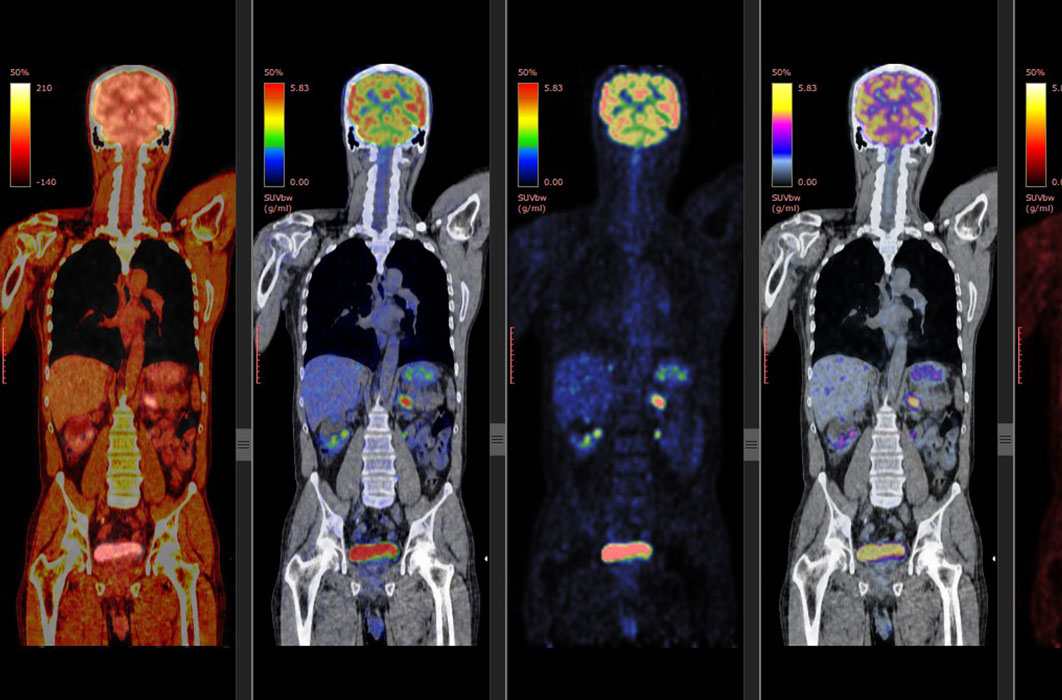POSITRON EMISSION TOMOGRAPHY AND COMPUTED TOMOGRAPHY (PET/CT)

WHAT IS PET/CT?
Positron Emission Tomography (PET) is a type of nuclear imaging that uses small doses of radiation to produce an image of the body. A PET/CT is when a PET scanner is physically joined with a CT scanner, which produces better image quality. This allows doctors to evaluate a variety of diseases anywhere in the body, including the heart and brain.
What is PET/CT used for?
PET/CT is performed as an outpatient procedure and requires injection of a small amount of radioactive material. The scan has many uses because of its high image quality. Some of the most common uses include:
- Determine the extent or stage of cancer
- Determine whether a growth is malignant (cancerous) or benign (non-cancerous)
- Determine the response to cancer treatment
- Cardiac or heart imaging
- Evaluation of some brain diseases
- Evaluation of patients who have memory disorders, such as Alzheimer’s Disease and seizure disorders that are not responsive medicine
How to prepare for a PET/CT
Because PET/CT requires injection of a small dose of radioactive material, some special preparation is required before your scan. To prepare for a PET/CT, please:
- Do not eat or drink anything other than water for 4 hours prior to your PET/CT exam
- Drink one 10 oz glass of water 2 hours prior to your exam and a second 10 oz glass of water 1 hour prior to your exam
- Arrive 30 minutes prior to your exam in order to register
- Most exams require a mild sedative, so bring someone with you to drive you home after the test
- Wear warm and comfortable clothing
- Bring a list of any medications you are currently taking
- Bring a copy of the order for the procedure from your referring physician, your insurance card and photo identification
- Refrain from exercising for 24 hours before your procedure
What to expect during a PET/CT?
The PET/CT procedure typically lasts 2-3 hours. First, you will receive an injection of a small amount of radioactive glucose (sugar) that acts as a “tracer” and enables evaluation of glucose function in the body. There are no known side effects to this injection. After your injection, the exam may begin immediately, or may begin after an “uptake period,” depending on the type of examination being requested. You may be asked to rest in a quiet room and avoid significant movement or talking to ensure the solution moves through the body correctly.
The PET/CT scanner is very similar in size to a CT scanner. The technologist will have you lie comfortably on an imaging table while the scanner detects the concentration of the tracer in your body to produce images.
When your examination is over, you may resume your normal daily activities unless otherwise instructed by your doctor. One of our board-certified radiologists will review the images and send a report to your doctor.
What if I’m claustrophobic?
Some claustrophobic patients may experience a “closed in” feeling during a PET/CT scan. If this is a concern, please let us know prior to your appointment. Conscious sedation may be available, depending on your preferred location.
What if I require contrast?
Some PET/CT examinations require that you take a special dye, often called “contrast.” Contrast can provide clearer images and allow better diagnostic capabilities. If you are given contrast, you might be asked not to eat or drink anything for 3-4 hours before the test. Contrast given through an IV might cause a metallic taste in the mouth, nausea and a warm flushing sensation. These sensations are normal and usually go away within a few minutes. Contrast typically does not cause symptoms; however, some mild symptoms, such as nausea, headache or itching. More complex side effects are rare.
If you have kidney disease or diabetes, you should receive plenty of fluids before and after the test and be closely monitored for kidney problems. If you have diabetes or are on kidney dialysis, talk to your health care provider before the test about your risks.